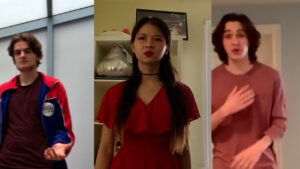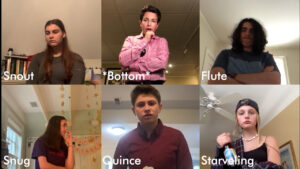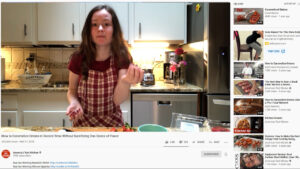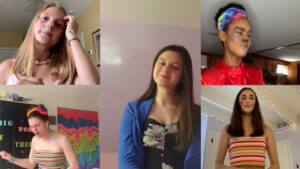We all have fond and cozy memories of the first few months of COVID in 2020– hunting for decent masks, social distancing at the supermarkets, spraying everything that came through our front doors with alcohol. Here’s my summer-of-2020 story.
One of the ways I coped was to take a lot of those theatrical plays I’d shot, and make them available for viewing on YouTube. I know some people at Curio Theater had worked with Friends’ Central High School, and maybe that flood of video prompted some memories, because I got an email asking if I could help them out with their annual theatrical production. Which couldn’t happen anymore because of COVID. So, maybe perhaps, could we do it via video conferencing or something…?
I’d never done anything like this before, but I love a challenge. The person I spoke to was Marielle B–, whom I’d assumed was a teacher, but it turned out she was the high school senior running the project.
The original proposal was that we’d use a conferencing system like Zoom, and each student would perform their part at home– maybe in one continuous performance. We decided early on that that wouldn’t work. Nearly everyone would have to use the freeware version of those programs, and those programs are limited in certain ways. They could record only so much video, or record it in some low resolution, or it could record only as a multi-screen video with everyone in a separate window. Or, the app would decide which audio tracks to use. And then there was the problem of audio and video lag: each person would have to wait until the other person was properly done speaking.
So Marielle and I worked out an alternative. We’d ask the students to set up their h0me video cameras, or smartphones, next to their computers. They’d still use Zoom, but only to be able to see each other and perform against each other. After they did a scene, they’d send me the video files shot with the video camera.
As we talked, we realized that we had some advantages here. Marielle and her classmates could shoot scene-by-scene, so the project didn’t need to pull every actor together all the time. If we’d miss something, Marielle could get the actor to re-record a single line or scene on their own, and I’d make it fit. And we weren’t automatic arrangement of feeds that a teleconferencing system would force onto us: we could arrange the video feeds any way we liked, cut to dramatic close-ups when we liked, and generally stretch the form a little.
Best of all, this approach gave us a chance to add some nice quarantine-and-COVID jokes. For example, there’s a scene in the play when a crew of actors, or “mechanicals,” arrive on the scene and start arguing about the play they’re going to perform. So we arranged the video streams to looks like a teleconference, with electronic bloops when the actors “arrive” in the chat room.
Since this was recorded in all the students’ homes… well, why not stage Helena’s angry monologue in her kitchen, as she angrily makes a smoothie on her cooking video blog?
And there’s the fight between Lysander and Demetrius– well, if they’re in two different video windows, how can they fight? I like what we came up with.
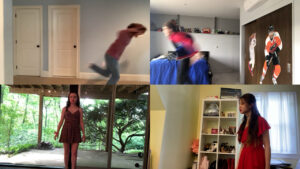 |
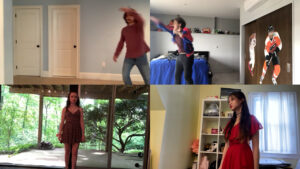 |
Of course a musical interlude is just made for a nice, split-screen arrangement as well.
One thing that was really gratifying for me was when Marielle asked if she could edit a scene or two. We’d talked about editing techniques a bit, so she wanted to try it out. I was surprised at how good her scenes were. She’d caught on to things like the right reactions, overlapping dialogue, slicing out dead spots… If she goes into theater and filmmaking, like Sally Potter or Julie Taymor, I’m going to pat myself on the back for mentorship. (I kept urging her to get Sidney Lumet’s book Making Movies, the best book on the subject by an acknowledged master.)



